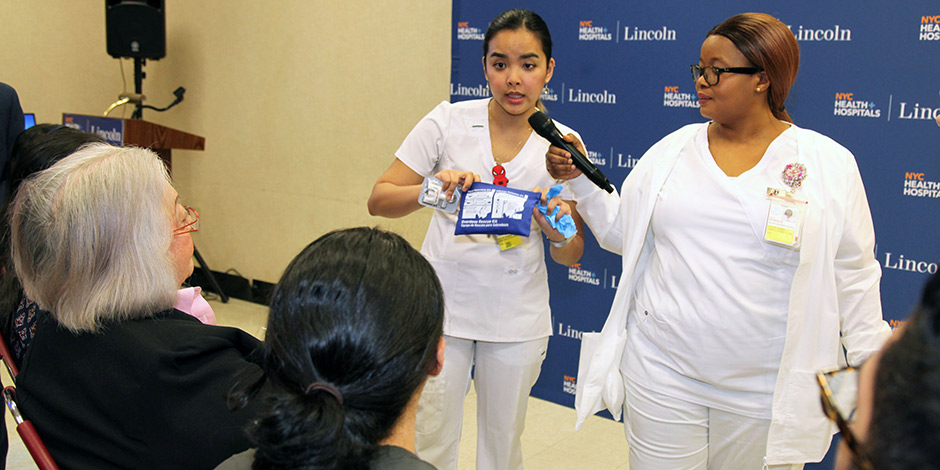New York State Certifies 17 NYC Health + Hospitals Sites as Opioid Overdose Prevention Programs
Mar 13, 2018

NYC Health + Hospitals today announced that 17 of its sites are now certified Opioid Overdose Prevention Programs. The certification by the New York State Department of Health enables the 11 public hospitals and six large Gotham Health centers to routinely dispense naloxone based on best practices, including overdose prevention training of patients and community members. Certified Opioid Overdose Prevention Programs are part of the health system’s efforts to transform care for New Yorkers overcoming substance misuse.
“Simply stated, increasing naloxone availability saves lives,” said Mitchell Katz, MD, president and chief executive officer of NYC Health + Hospitals. “Making naloxone easily accessible to our patients and members of the community who may have friends or family struggling with opioid use is an important part of New York City’s response to the opioid epidemic. And our pursuit of State certification at all these sites underscores how important a priority this is for us.”
Since the city launched HealingNYC in March 2017, NYC Health + Hospitals has distributed more than 2,100 naloxone kits and implemented the following initiatives to make naloxone available throughout the health system:
- Emergency department protocols related to nonfatal overdoses have been standardized in all 11 health system emergency departments. Free naloxone distribution to at-risk patients is one focus of these protocols.
- NYC Health + Hospitals/Lincoln in the South Bronx, an area with some of the highest rates of overdose in the city, has expanded naloxone distribution to make naloxone kits more readily accessible to patients and family or friends who may know someone effected by opioid use. Naloxone kits are distributed broadly by the hospital’s pharmacy, beyond its substance use disorder program, to include the emergency department and behavioral health and chemical dependency services.
- NYC Health + Hospitals/Lincoln also became the first hospital to open a hospital-based naloxone kit distribution center to make the drug available free of charge to the community at large, without the need for a prescription. Kits are available to anyone 12 and older, and everyone who receives a kit will also be trained by hospital staff, which takes approximately five minutes. Training includes how to identify someone who is suffering from an overdose and how to properly administer the naloxone nasal spray.
Plans are underway to add similar naloxone kit distribution centers to the 10 other public hospitals, as well.
In addition, in 2014, New York City established one of the country’s first jail-based naloxone distribution programs at the Rikers Island Visitor Center. Through this program, Correctional Health Services, a part of NYC Health + Hospitals, distributes naloxone once a week to the visitors of inmates who are at high risk of overdose upon release from jail.
Annually, approximately 20,000 NYC Health + Hospitals patients suffer from opioid use disorder, of which approximately 14,000 visit NYC Health + Hospitals emergency departments. According to the NYC Department of Health, drug overdose deaths in 2016 increased 46 percent from 2015, and in 2016 more New Yorkers died from opioid-related overdose than from car crashes and homicides combined. In 2017, New York City announced its goal to reduce opioid overdose deaths by 35 percent over the next five years.
The State’s Opioid Overdose Prevention Program certification is valid for two years and requires monthly reporting related to kit distribution.
Naloxone is used to prevent an overdose of opioids, including prescription painkillers, heroin and fentanyl by reversing the drug’s toxic effects. Administered by nasal spray, the medication is used when someone is showing signs of opioid overdose, which include when a person is unresponsive, breathing slows or stops, or lips and/or fingernails turn blue, pale, or gray.
NYC Health + Hospitals’ Opioid Overdose Prevention Programs, by Borough
Bronx
- NYC Health + Hospitals/Lincoln
- NYC Health + Hospitals//Jacobi
- NYC Health + Hospitals/North Central Bronx
- NYC Health + Hospitals/Gotham Health, Morrisania
- NYC Health + Hospitals/Gotham Health, Belvis
Brooklyn
- NYC Health + Hospitals/Coney Island
- NYC Health + Hospitals/Kings County
- NYC Health + Hospitals/Woodhull
- NYC Health + Hospitals/Gotham Health, Cumberland
- NYC Health + Hospitals/Gotham Health, East New York
Manhattan
- NYC Health + Hospitals/Bellevue
- NYC Health + Hospitals/Harlem
- NYC Health + Hospitals/Metropolitan
- NYC Health + Hospitals/Gotham Health, Gouverneur
- NYC Health + Hospitals/Gotham Health, Sydenham
Queens
- NYC Health + Hospitals/Elmhurst
- NYC Health + Hospitals/Queens